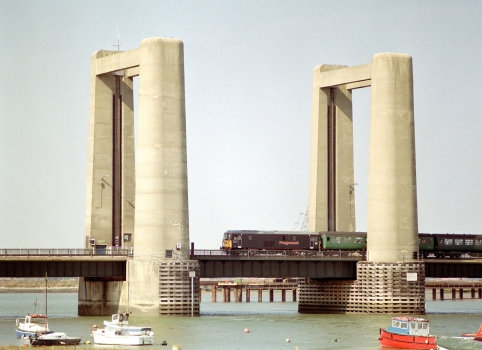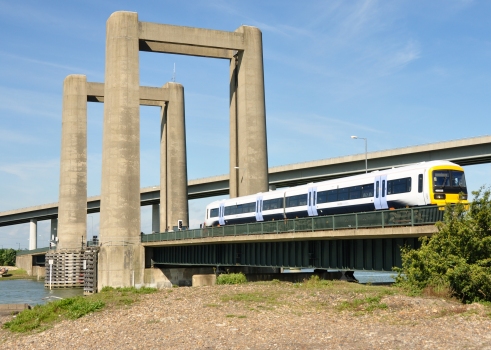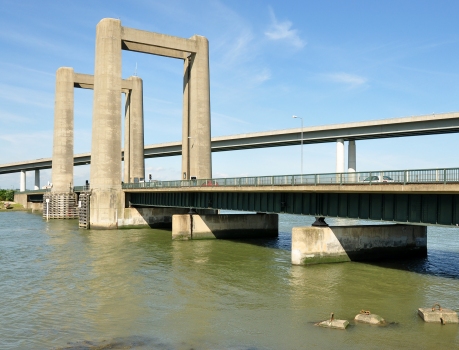General Information
| Completion: | 1960 |
|---|---|
| Status: | in use |
Project Type
| Structure: |
Vertical lift bridge |
|---|---|
| Function / usage: |
Road bridge Railroad (railway) bridge |
| Material: |
Steel bridge |
Location
| Location: |
Isle of Sheppey, Swale, Kent, South East England, England, United Kingdom |
|---|---|
| Crosses: |
|
| Next to: |
Second Swale Crossing Bridge (2006)
|
| Coordinates: | 51° 23' 26.29" N 0° 45' 0.19" E |
Technical Information
Dimensions
| main span | 37 m | |
| width | 15 m | |
| number of tracks | 1 | |
| number of lanes | 2 |
Materials
| deck |
steel
|
|---|
Excerpt from Wikipedia
The Kingsferry Bridge is a combined road and railway vertical-lift bridge which connects the Isle of Sheppey to mainland Kent in South East England. The seven-span bridge has a central lifting span which allows for tall ships to pass.
In 1860, the first bridge on this site was constructed for the London, Chatham and Dover Railway Company on their line between Kent and the port of Sheerness. Originally a bascule bridge, it opened to allow large vessels to navigate past and not obstruct maritime traffic on the Swale. On 17 December 1922, the Norwegian cargo ship Gyp collided with the bridge; it was repaired and returned to service after 10 months. The bascule bridge was closed in the 1950s and was replaced by the present Kingsferry Bridge. The new bridge was designed by Mott, Hay and Anderson, and constructed by John Howard, in conjunction with Dorman Long and Sir William Arrol & Co.
Swale railway station is at the southern end of the bridge. When opened, the structure carried the A249; up to 30,000 vehicles per day used the bridge. Most traffic has been diverted onto the Sheppey crossing, which opened in 2006. The number of road vehicles crossing Kingsferry Bridge has dropped but it is still maintained as a key roadway between the island and the mainland.
History
Background
In 1860, the first bridge on the site was completed. It was a bascule bridge, built to carry railway traffic across the Swale between the Isle of Sheppey and mainland Kent for the London, Chatham and Dover Railway Company. The LCDR operated rail traffic to the port of Sheerness. The LCDR and the South Eastern Railway (SER) amalgamated to create the South Eastern and Chatham Railway which replaced major elements of the bridge and during 1904, a replacement Scherzer-type moving section was installed.
On 17 December 1922, the Norwegian cargo ship Gyp collided with the bridge causing extensive damage and a lengthy closure. Repairs took ten months before it was re-opened to traffic. It remained in use until the early 1950s when it was replaced by the present bridge.
Current bridge
During the late 1940s, it was recognised that a new bridge was required. The bridge did not meet traffic demands; people wanted to use road vehicles rather than being restricted to boats or trains. The design for the replacement bridge incorporated a roadway alongside the electrified tracks and a pedestrian footpath. The new bridge's elevation was dictated by the low-lying river banks and the railway limited its maximum possible gradient.
In December 1957, construction commenced. The resident engineer was R. Hodges and the civil engineering company John Howard & Co Ltd was appointed the principal contractor; the steelwork was sourced from Dorman Long (Bridge & Engineering) Co Ltd and the machinery was provided Sir William Arrol & Co. On 20 April 1960, work on the bridge was completed. Kingsferry Bridge cost £1.2 million. On 20 April 1960, it was officially opened by the Duchess of Kent.
For many decades Kingsferry Bridge was the only crossing to Sheppey. Before the opening of the Sheppey Crossing in 2006, up to 30,000 vehicles per day crossed the bridge. Road traffic was inconvenienced when the bridge was opened to enable the boats to pass, usually at high tide. Each closure lasts for 15 to 20 minutes.
Kingsferry Bridge has been raised over 100,000 times during its lifetime; each lift has to be recorded. During January 2015, a bid by Iwade Parish Council to have the bridge recognised as a listed structure was turned down by English Heritage as it did not fall into the categories used to determine those sites that are most in need of protection.
During 2010, the Kent Police borrowed £73,000 from Swale Borough Council for an automatic number plate recognition system (ANPR). The system was installed on the Sheppey Crossing and Kingsferry Bridge that year in a bid to track criminal's movements.
Mechanics and structure
The bridge is a combined road and railway vertical-lift bridge. It carries a 7.3-metre wide two-lane road, a 1.8-meter wide footpath and a single-track electrified railway line. Although the railway operates by electrified third rail, there is no electrification over the moving section of the bridge. To cross the bridge, electric trains coast across the gap in the electrification.
Structurally, the bridge comprises two sets of approach spans, each of which has three spans, either side of the central main lifting span. Each span comprises two riveted longitudinal steel deck girders, supporting riveted cross girders, which in turn support a reinforced concrete slab deck. Each set of three spans consists of two simply supported end spans which continue as cantilevers approximately 1/5 span into the middle span. The central 3/5 span sections are simply supported drop in spans supported by halving joints. The main span is a structurally independent lifting span. The bearings are inset from the end lifting beams. Spans 1, 3, 5 and 7 are 24.994 meters c/c of bearings. Spans 2 and 6 are 26.213 meters, with halving joints 5.334 meters from both end and a 15.547 meters suspended span. The central lifting span, Span 4, is 31.242 meters c/c of bearings, with cantilevers of 3.124 meters either end to the lifting cross girders. The approach spans have cross girders, spaced 2.438 meters apart, while the lifting girder features cross girders spaced at 6.248 meters intervals.
The bridge abutments are of cellular concrete construction. Pier 1, 2, 5 and 6 comprise five reinforced concrete circular caisson piles, formed as piers. They have a diameter of 1.37 meters and are spaced at 5.49 meter intervals between centres. A reinforced concrete cap, which has a height of 4.57 meters and a depth of 1.83 meters, sits above the piers. Below the level of river bed is a cast iron subway, which links piers 3 and 4 of the bridge’s lifting span.
Piers 3 and 4 support the lifting span in addition to the approach spans. They are constructed of a pair of circular reinforced concrete caissons founded in the river bed. The caissons are linked by a concrete structure, positioned at approximately low tide level, which accommodates the machinery room and bearings for the lifting span. Two concrete towers extend above road level; both the towers and their piers are hollow as to allow them to support the lifting cables and counterweights. The towers are braced near the top by two concrete beams.
The moving section of the bridge is actuated via a pair of large electric motors located beneath the deck of the roadway. At either side are engine rooms containing equipment for operating the wire ropes and counterweights that lift and lower the bridge. Three storage areas and the bridge control room are located in the bases of the towers. The bridge can only be lifted when the Sittingbourne railway signalman has given authorisation to proceed when a train has passed out of the relevant track section. The maximum bridge lifting height is 84 feet; on attaining its full lift height, a klaxon is sounded to give auditory confirmation. To ensure that the lifting span has been correctly set back into place, it is equipped with locating devices to precisely align the tracks. To prevent operations being disrupted by a supply-related power failure, a standby diesel generator, capable of generating up to 40 kW, is located on site.
Text imported from Wikipedia article "Kingsferry Bridge" and modified on 23 July 2019 under the CC-BY-SA 3.0 license.
Participants
Currently there is no information available about persons or companies having participated in this project.
Relevant Web Sites
- About this
data sheet - Structure-ID
20016596 - Published on:
13/06/2005 - Last updated on:
05/06/2017







